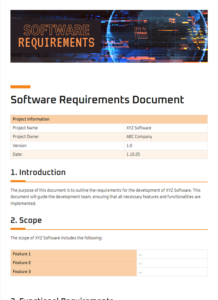Software Requirement Specification (SRS) plays a crucial role in the software development lifecycle by defining the precise requirements that a software system must fulfill. An SRS template provides a structured framework to document these requirements comprehensively and consistently. Leveraging an SRS template ensures that all essential aspects are addressed, enhancing the clarity and completeness of the specification.
An effective SRS template includes sections such as an introduction, glossary, functional requirements, non-functional requirements, and appendices. The introduction outlines the purpose, scope, and context of the SRS. The glossary defines important terms used throughout the document, facilitating comprehension. Functional requirements describe the specific tasks and functionalities that the software must perform. Non-functional requirements address broader system attributes, such as performance, reliability, and usability. Appendices provide supplementary information, such as use cases and acceptance criteria.
Components of an Effective SRS Template
A comprehensive SRS template encompasses various sections that work in concert to provide a thorough specification of the software requirements. These components include:
- Introduction: Defines the purpose, scope, and context of the SRS, providing an overview of the software system.
- Glossary: Defines and explains key terms and abbreviations used in the document, ensuring clarity and consistency.
- Functional Requirements: Describes the specific functionalities and tasks that the software must perform, including input, output, and processing details.
- Non-Functional Requirements: Specifies broader system attributes such as performance, reliability, security, usability, and maintainability, ensuring that the software meets the necessary quality standards.
- Dependencies: Identifies external factors and dependencies that may impact the software’s functionality, ensuring a comprehensive understanding of the system’s requirements.
- Appendices: Provides supplementary information such as use cases, acceptance criteria, and traceability matrices, enhancing the clarity and understandability of the SRS.
Benefits of Using an SRS Template
An SRS template offers numerous benefits that enhance the quality and efficiency of software development:
- Consistency: Enforces a standardized structure and format for documenting requirements, ensuring that all SRS documents follow a consistent approach.
- Comprehensiveness: Provides a comprehensive framework for capturing all essential aspects of the software requirements, reducing the likelihood of omissions.
- Clarity: Facilitates clear and concise documentation of requirements by providing predefined sections and guidance, improving communication among stakeholders.
- Traceability: Enables easy tracking of requirements throughout the development lifecycle, simplifying the process of verifying and validating the software against its specifications.
- Risk Mitigation: Helps identify and mitigate potential risks early in the development process by ensuring that all critical requirements are addressed.
Conclusion
An SRS software requirement specification template serves as a valuable tool for capturing and documenting software requirements in a structured and comprehensive manner. By utilizing a template, development teams can ensure that all essential aspects are addressed, enhancing the clarity, consistency, and completeness of the specification. The benefits of using an SRS template extend beyond documentation, contributing to improved communication, risk mitigation, and overall software quality.
Adopting an SRS template promotes a collaborative and efficient approach to software development by establishing a common understanding among stakeholders and providing a solid foundation for subsequent phases of the project lifecycle.

